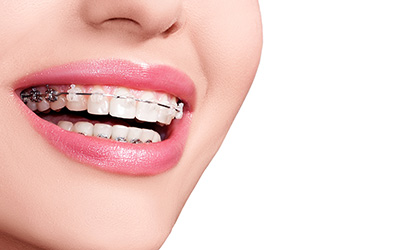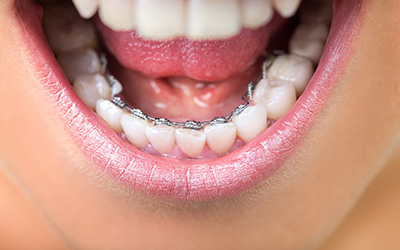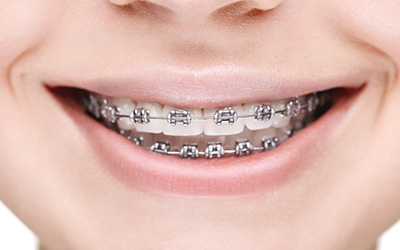Traditional Metal Braces (Stainless Steel)
Stainless steel fixed appliances (braces) are comprised of small stainless steel squares (“brackets”) that are bonded with composite resin (dental adhesive) directly to the enamel surfaces of the teeth. A protective layer of dental “sealant” is carefully applied to ensure safe placement and removal of the appliances, thereby preserving the enamel. The braces alone do not move teeth; they are simply stable guidance mechanisms that allow wires and other appliances to affect the actual tooth movement (wires, chains, elastics, coil springs, and other devices).
Cleaning:
Careful brushing is advised two to three times a day. Brushing all around each and every bracket is essential to the maintenance of dental health during the orthodontic process. Flossing – threading the floss under the wire at each point of contact – is advised at least once a day. A fluoride mouth rinse may also be helpful to make sure that all exposed surfaces of the teeth are protected during appliance wear.
What to Expect:
Patients can expect to experience soreness of the teeth and irritation of the lips and cheeks for approximately 1-2 weeks.
Adjustment visits are scheduled at 4-8 week intervals as needed to affect the desired changes. The most important element of orthodontic treatment is patient compliance which includes excellent brushing and wearing of elastics. A patient can expect 2-3 days of MINOR soreness in the teeth after an adjustment as the teeth respond to the changes implemented.
Remember:
The patient and orthodontist are partners in this adventure and helpful participation by the patient can make the process proceed as planned. Careful oral hygiene and compliance with all prescribed appliances can help to make the process a raging success!
Ceramic Clear Upper Braces With Stainless Steel Lower Braces

Clear or (Ceramic) fixed appliances (braces) used in combination with stainless steel fixed appliances, are comprised of small ceramic or stainless steel squares (“brackets”) that are bonded with composite resin (dental adhesive) directly to the surfaces of the teeth. A protective layer of dental “sealant” is applied to ensure safe placement and removal of the appliances, thereby preserving the enamel. Bands (stainless steel rings with braces welded to the steel) are often used on the tooth to ensure appliance retention. The braces alone do not move teeth; they are simply stable guidance mechanisms that allow wires and other appliances to affect the actual tooth movement.
Cleaning:
Careful brushing is advised two to three times a day. Brushing all around each and every brace is essential to the maintenance of dental health during the orthodontic process. Flossing – threading the floss under the wire at each point of contact – is advised at least once a day. A fluoride mouth rinse may also be helpful to make sure that all exposed surfaces of the teeth are protected during appliance wear.
What to Expect:
Patients can expect to experience soreness of the teeth and irritation of the lips and cheeks for approximately 1-2 weeks.
Adjustment visits are scheduled at 4-8 week intervals as needed to affect the desired changes. The most important element of orthodontic treatment is patient compliance which includes excellent brushing and wearing of elastics. A patient can expect 2-3 days of MINOR soreness in the teeth after an adjustment as the teeth respond to the changes implemented.
Remember:
The patient and orthodontist are partners in this adventure and helpful participation by the patient can make the process proceed as planned. Careful oral hygiene and compliance with all prescribed appliances can help to make the process a raging success!
Lingual Braces

Lingual braces are specially designed stainless steel brackets that are placed by Dr. Turner and glued to the inside surfaces of the teeth. Lingual braces appear almost “invisible” since they are behind the teeth. This treatment is best suited for those who have alignment concerns on the lower arch only.
A protective layer of dental “sealant” is applied to ensure safe placement and removal of the appliances, thereby preserving the enamel. The braces alone do not move teeth; they are simply stable guidance mechanisms that allow wires and other appliances to affect the actual tooth movement (wires, chains, elastics, coil springs, and other devices).
Cleaning:
Careful brushing and flossing are advised daily. Brushing all around each and every brace is essential to the maintenance of dental health during the orthodontic process. Flossing – threading the floss under the wire at each point of contact – is advised at least once a day. Extra time and effort with hygiene will be necessary with Lingual Braces as access to these appliances can prove difficult at first. A fluoride mouth rinse may also be helpful to make sure that all exposed
What to Expect:
2-3 days of MINOR soreness in the teeth after an adjustment as the teeth respond to the changes implemented. As you move through treatment, the bite may feel “off” for a period of time. This is normal and will resolve as we place the teeth in the proper position.
Remember:
The patient and orthodontist are partners in this adventure and helpful participation by the patient can make the process proceed as planned. Careful oral hygiene and compliance with all pre- scribed appliances can help to make the process a raging success!

